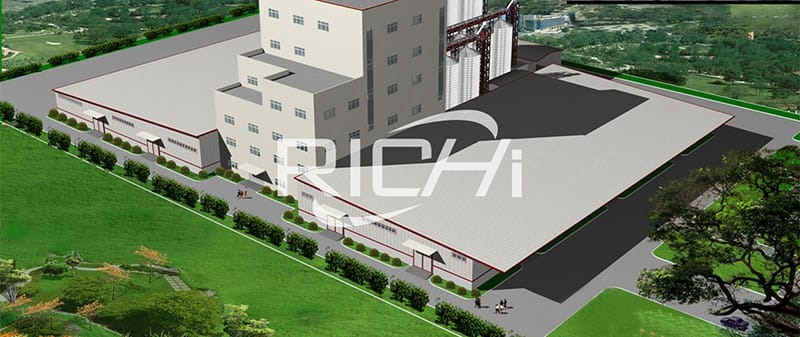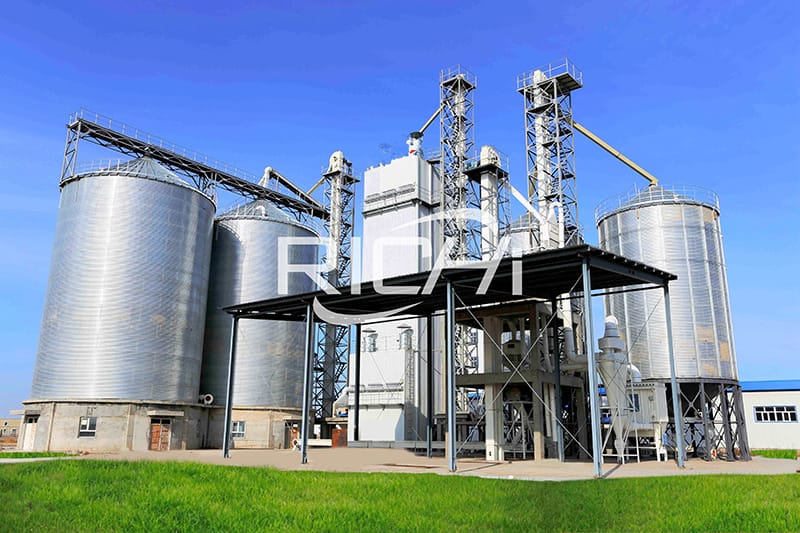Analysis of the troubles and elimination procedures of feed processing equipment in animal feed mills
1. The animal feed production line, no matter which feed mill manufacturer produces, has the following characteristics.
(1) The feed production processing line has large investment in fixed assets, large production scale, large consumption of raw materials, high labor productivity, and large output value. It is a form of production organization with high labor efficiency.
(2) It consists of many processing equipment, conveying equipment, electrical appliances, steam control components, etc., organically combined according to the needs of advanced processing technology, with high degree of automation and close contact with each other; the equipment can operate continuously for 24 hours in 3 shifts . If a certain equipment or a certain component fails, the entire line or a certain process section will stop production.
(3) Although the operation of the feed line is simple and there are few workers, the technical content of equipment management and maintenance is high, and the workload is also large.
Therefore, to ensure that feed processing equipment is always in good condition, it is necessary to strengthen equipment management and strictly control the occurrence of equipment failures. In order to achieve the purpose of reducing failure rate, reducing maintenance costs and extending service life.
Feed equipment failure generally refers to an event or phenomenon in which the equipment or system loses or reduces its specified function during use. The equipment is equipped by the enterprise to meet the technological requirements of a certain production object or to complete the design function of the engineering project. The function of the equipment reflects its value in production activities and the degree of guarantee for production. In modern animal feed production plant, due to the complex structure of the equipment, the high degree of automation, and the close connection of various parts and systems, equipment failures, even partial failures, will cause the entire equipment to stop and the entire assembly line to stop production. Equipment failure directly affects the quantity and quality of feed mills products.

2. Classification of feed processing equipment failure
Equipment failures are diverse and can be classified from different angles.
(1) According to the fault occurrence status, it can be divided into:
① Gradual failure. It is caused by the gradual deterioration of the initial parameters of the equipment, and most of the machine failures belong to this type of failure. This type of failure is closely related to the process of material wear, corrosion, fatigue and creep.
② Sudden failure. It is caused by the combined action of various unfavorable factors and accidental external influences, which are beyond the limit that the equipment can bear. For example: the safety pin breaks due to the entry of iron or overload in the pressing chamber of the granulator; the break of the sieve plate due to the break of the hammer of the hammer mill. Such failures often happen suddenly, without any prior warning.
Sudden failures mostly occur in the initial stage of equipment use, and are often caused by defects in design, manufacturing, assembly, and materials, or operating errors or illegal operations.
(2) According to the nature of the fault, it can be divided into:
①Intermittent failure. The equipment loses some of its functions in a short period of time, and it can be restored after a little repair and debugging, without replacing parts.
②Permanent failure. Some parts of the equipment are damaged and need to be replaced or repaired before they can be used again.
(3) Divided according to the degree of fault influence, it can be divided into:
① Complete failure. Cause the equipment to completely lose function.
②Local failure. Cause the loss of some functions of the equipment.
(4) Divided according to the cause of the failure, it can be divided into:
①Abrasion failure. Failure due to normal wear and tear of equipment.
② Misuse failure. Failure caused by incorrect operation or improper maintenance.
③Inherent weak failure. Due to design problems, the equipment has weak links and malfunctions during normal use.
(5) Divided according to the risk of failure, it can be divided into:
① Dangerous failure. For example, the safety protection system loses its protective effect due to failure when it needs to act, causing personal injury and machine tool failure; failures caused by brake system failure.
② Security failure. For example, the safety protection system will act when it is not needed; the machine tool cannot be started.
(6) Divided according to the occurrence and development of the fault, it can be divided into;
① Random failure. The time of failure is random.
②There are regular faults. The occurrence of failures has a certain pattern.
Each type of failure has its main characteristics, the so-called failure mode, or failure state. The failure status of various equipment is quite complicated, but the following can be summarized: abnormal vibration, wear, fatigue, cracks, cracks, excessive deformation, corrosion, peeling, leakage, blockage, relaxation, insulation aging, abnormal noise, Oil quality deterioration, material deterioration, adhesion, pollution and others. Different types of equipment account for different failure modes.

3. Failure analysis and troubleshooting procedures
In order to ensure the quick and effective fault analysis and troubleshooting, certain procedures must be followed, which are roughly as follows.
(1) Perform symptom analysis while maintaining the scene
① Ask the operator
a. What happened? Under what circumstances? When did it happen?
b. How long has the equipment been running?
c. Are there any abnormal phenomena before the fault occurs? Are there any sound or sound and light alarm signals? Is there any smoke or odor? Is there any misoperation (pay attention to the inquiry method)?
d. Is the control system operating normally? Is there any change in operating procedures? Are there special difficulties or abnormalities during operation?
② Observe the condition of the whole machine and various operating parameters
a. Is there any obvious abnormality? Is there any blockage or damage to the parts? Is the pipeline loose or leaking? Is the cable (line) broken, scratched or burned?
b. What are the changes in equipment operating parameters? Is there any obvious interference signal? Is there any obvious damage signal?
③Check the monitoring indicating device
a. Check whether all readings are normal, including the readings of pressure gauges and other instruments, and the oil level.
b. Check whether the filter, alarm and interlocking device, printout or display are normal.
④ Inspection of jog equipment (under permitted conditions)
Check intermittent conditions, persistent conditions, fast forward or slow forward conditions, to see whether these conditions affect the output, whether it may cause damage or other dangers.
(2) Inspection equipment (including parts, components and circuits)
①Using sensory inspection (continue the process of in-depth observation)
a. Look: Whether the plug and socket are abnormal, whether the motor or pump is running normally, whether the control adjustment position is correct, whether there is arc or burnt trace, the filament of the electron tube is not bright, whether there is liquid leakage, whether the lubricating oil circuit Unblocked and so on.
b. Touch: the vibration of the equipment, the heat of the element (group), the temperature of the tubing, and the state of mechanical movement.
c. Listen: Whether there is any abnormal sound.
d. Smell: whether there is burnt smell, leaking smell, other peculiar smell.
e. Check: The shape and position of the workpiece change, the change of equipment performance parameters, and the line abnormality check.
②Assess inspection results
Assess whether the fault judgment is correct, whether the fault clue is found, and whether the inspection results are consistent.
(3) Determination of fault location
①Identify the system structure and determine the test method
Consult the equipment manual to identify the structure of the equipment, what method is used for testing, what testing methods are needed, what test parameters or performance parameters may be obtained, under what operating conditions, what safety measures must be followed, and whether operating permits are required certificate.
②System detection
Adopt the most suitable technology for system structure inspection. At a suitable test point, compare the results obtained according to input and feedback with normal values or performance standards to find out suspicious locations.
(4) Repair or replace
①repair
Find the cause of the failure, repair the equipment failure and take preventive measures; check the relevant parts to prevent the failure from spreading.
②Replace
Correctly assemble and debug replacement parts, and pay attention to related parts. The replaced parts are repaired or scrapped.
(5) Perform performance measurement
①Starting equipment
After the parts are assembled and debugged, start the equipment, first manually (or inching), and then perform no-load and load measurement.
②Adjust the load change speed from low to high, load from small to large, and measure the performance according to the specified standards.
③Expand the scope of performance test
According to needs, gradually expand the scope of performance test from part to system. Pay attention to the operating status of the system in the non-faulty area. If the performance meets the requirements, it will be delivered. If the requirements are not met, the fault location will be re-determined.
(6) Record and feedback
①Collect valuable information and data, such as the time of failure, failure phenomenon, downtime, repair time, replacement parts, repair effect, problems to be solved, settlement expenses, etc., and save them in files according to the specified requirements.
②Statistical analysis
Regularly analyze equipment usage records, analyze downtime losses, revise the memorandum catalog, find key measures to reduce maintenance operations, study failure mechanisms, and propose improvement measures.
③Report related failures to the competent authority according to the procedure and report to the feed mill equipment manufacturer.
If you want to built one complete pellet production line in your country, pls send the inquiry to us. We will customized design according to your requirement.



